Search Result
Results for "
Minor groove
" in MedChemExpress (MCE) Product Catalog:
3
Isotope-Labeled Compounds
| Cat. No. |
Product Name |
Target |
Research Areas |
Chemical Structure |
-
- HY-144333
-
|
|
DNA Alkylator/Crosslinker
|
Cancer
|
|
DNA crosslinker 1 (dihydrochloride) is a potent DNA minor groove binder with DNA binding affinity (ΔTm) of 1.1 °C. DNA crosslinker 1 (dihydrochloride) can be used for researching anticancer .
|
-

-
- HY-144336
-
|
|
DNA Alkylator/Crosslinker
|
Cancer
|
|
DNA crosslinker 3 (dihydrochloride) (compound 1) is a potent DNA minor groove binder with DNA binding affinity (ΔTm) of 1.4 °C. DNA crosslinker 3 (dihydrochloride) can be used for researching anticancer .
|
-
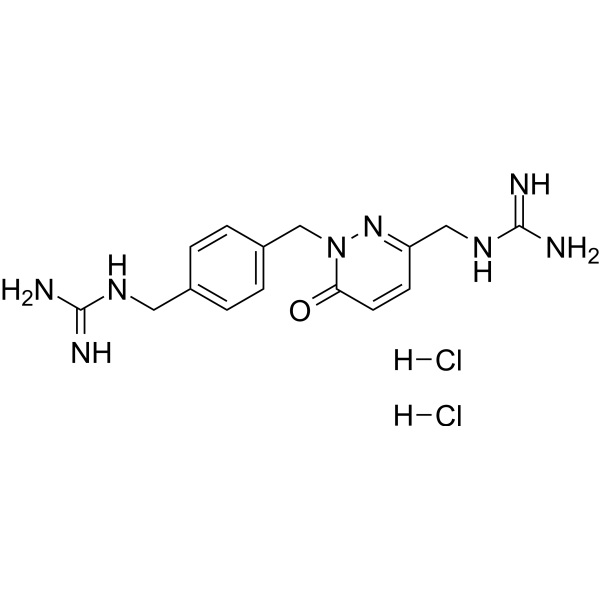
-
- HY-144337
-
|
|
DNA Alkylator/Crosslinker
|
Cancer
|
|
DNA crosslinker 4 (dihydrochloride) is a potent DNA minor groove binder. DNA crosslinker 4 (dihydrochloride) has certain inhibitory activity against cancer cells NCI-H460, A2780 and MCF-7. DNA crosslinker 4 (dihydrochloride) can be used for researching anticancer .
|
-

-
- HY-112058
-
|
NSC-82150
|
Antibiotic
Apoptosis
|
Infection
|
|
Distamycin A (NSC-82150), an oligopeptide antibiotic, is a minor groove binder which binds to B-form DNA, preferentially at A/T rich sites.Distamycin A can change Enediyne-induced DNA cleavage sites and enhances apoptosis .
|
-
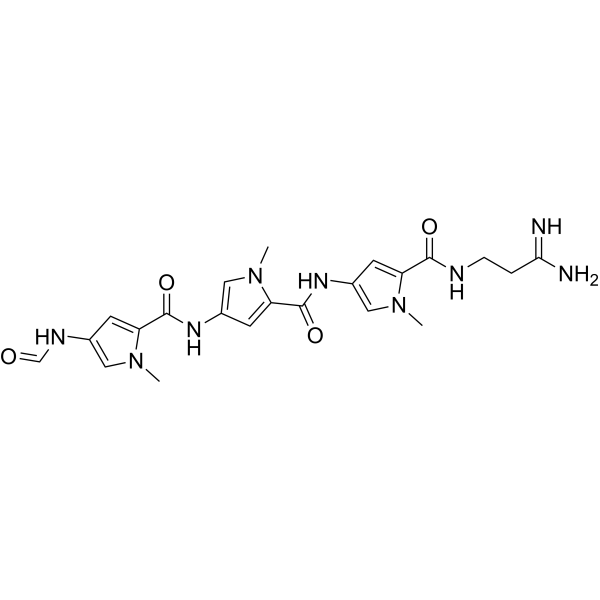
-
- HY-144335
-
|
|
DNA Alkylator/Crosslinker
|
Cancer
|
|
DNA crosslinker 2 (dihydrochloride) is a potent DNA minor groove binder with DNA binding affinity (ΔTm) of 1.2 °C. DNA crosslinker 2 (dihydrochloride) has certain inhibitory activity against cancer cells NCI-H460, A2780 and MCF-7. DNA crosslinker 2 (dihydrochloride) can be used for researching anticancer .
|
-
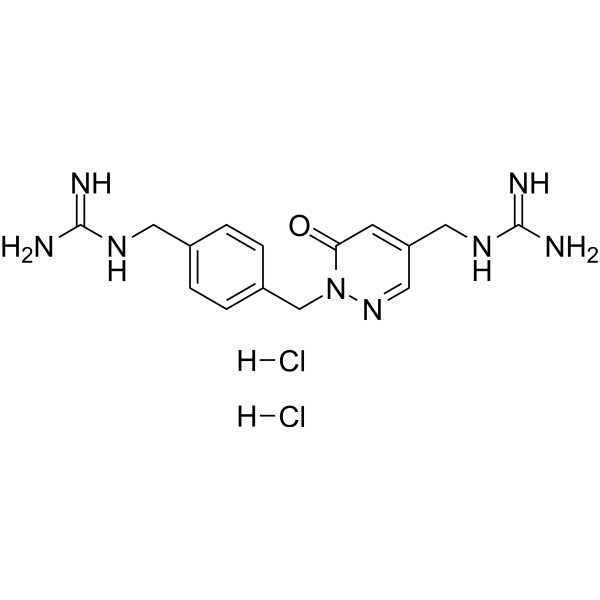
-
- HY-145287
-
|
|
DNA/RNA Synthesis
Parasite
|
Infection
|
|
S-MGB-234 is a minor groove binder of Animal African Trypanosomiasis (AAT). S-MGB-234 displays excellent in vitro activities against the principal causative organisms of AAT; Trypanosoma congolense, and Trypanosoma vivax. S-MGB-234 does not show cross-resistance with the current diamidine agents and are not internalized via the transporters used by diamidines .
|
-
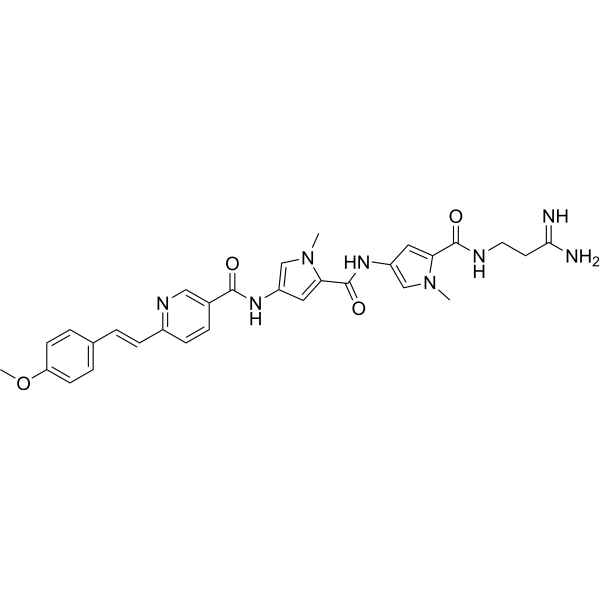
-
- HY-101127
-
|
PBD dimer
|
ADC Cytotoxin
|
Cancer
|
|
SGD-1882 is a cytotoxic, DNA minor-groove crosslinking agent pyrrolobenzodiazepine (PBD) dimer, acting as the payload for ADCs.
|
-

-
- HY-N0311
-
|
|
Others
|
Cancer
|
|
Emodin-8-glucoside is an anthraquinone derivative isolated from Aloe vera, binds to minor groove of DNA .
|
-
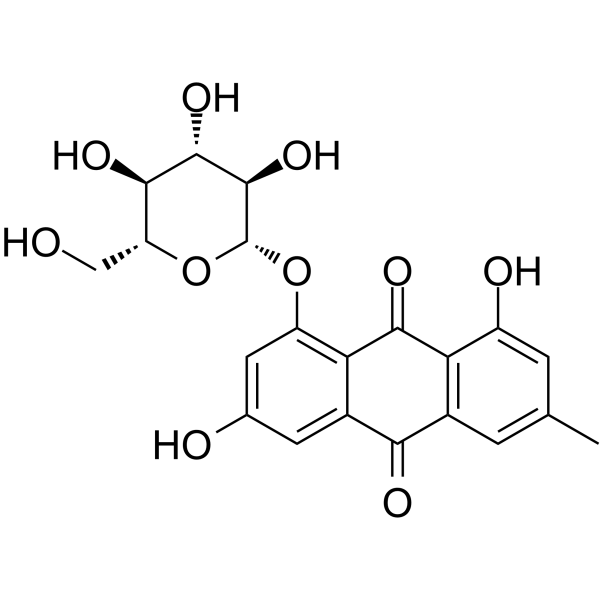
-
- HY-N9460
-
|
|
DNA Alkylator/Crosslinker
Antibiotic
|
Cancer
|
|
Sibiromycin is a naturally produced glycosylated pyrrolobenzodiazepines (PBDs). Sibiromycin is also a potent antitumor antibiotic that binds covalently to DNA in the minor groove at the NH2 of guanine .
|
-
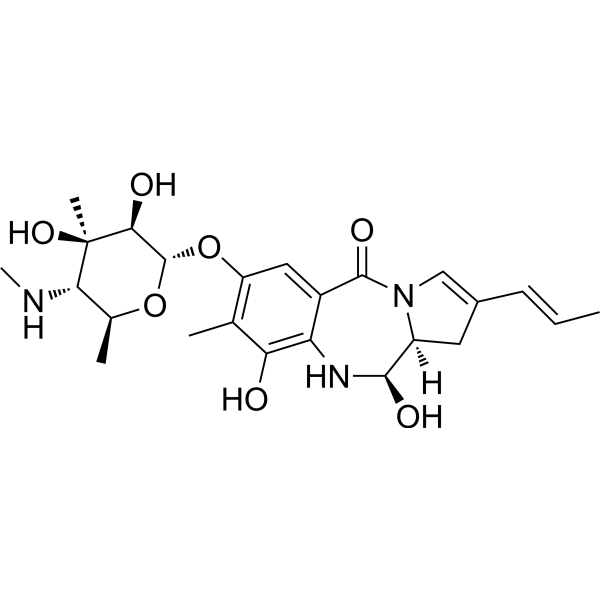
-
- HY-101161
-
SG3199
2 Publications Verification
|
DNA Alkylator/Crosslinker
ADC Cytotoxin
|
Cancer
|
|
SG3199 is a cytotoxic DNA minor groove interstrand crosslinking pyrrolobenzodiazepine (PBD) dimer. SG3199 is the released warhead component of the ADC payload Tesirine (SG3249) .
|
-
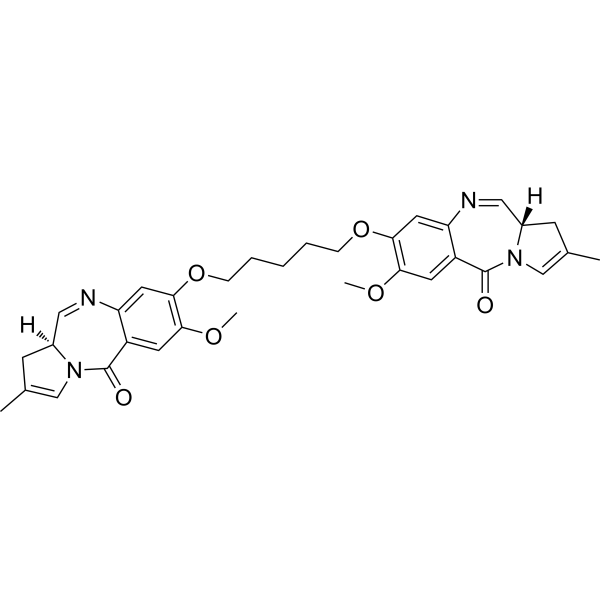
-
- HY-112899
-
|
|
ADC Cytotoxin
DNA Alkylator/Crosslinker
|
Cancer
|
|
DC1, an analogue of the minor groove-binding DNA alkylator CC-1065, is a ADC Cytotoxin. DC1 can be used in synthesis of antibody-drug conjugates for the targeted treatment of cancer.
|
-
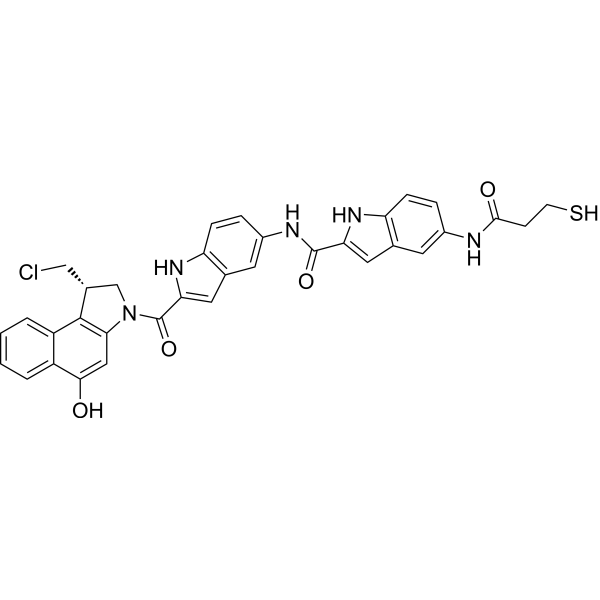
-
- HY-128873
-
|
|
ADC Cytotoxin
DNA Alkylator/Crosslinker
|
Cancer
|
|
Duocarmycin GA is an antibody agent conjugates (ADCs) toxin. Duocarmycin is a DNA alkylating agent that binds in the minor groove. Duocarmycin GA can be used against multi-agent resistant cell lines.
|
-
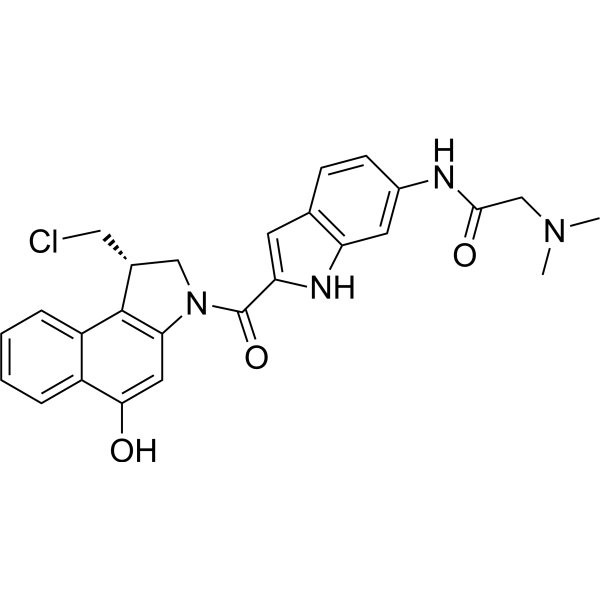
-
- HY-107770
-
|
|
ADC Cytotoxin
DNA Alkylator/Crosslinker
|
Cancer
|
|
Duocarmycin MB is an antibody agent conjugates (ADCs) toxin. Duocarmycin is a DNA alkylating agent that binds in the minor groove. Duocarmycin MB can be used against multi-agent resistant cell lines.
|
-

-
- HY-18987
-
|
|
|
|
|
Duocarmycin MA is an antibody agent conjugates (ADCs) toxin. Duocarmycin is a DNA alkylating agent that binds in the minor groove. Duocarmycin MA can be used against multi-agent resistant cell lines.
|
-
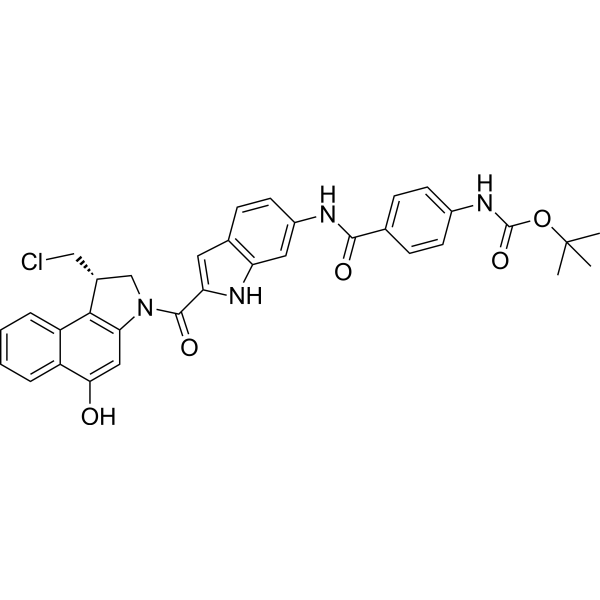
-
- HY-136289
-
|
|
Drug-Linker Conjugates for ADC
|
Cancer
|
|
MB-VC-MGBA is a agent-linker conjugate for ADC with potent antitumor activity by using MGBA (minor-groove-binding DNA-alkylating agent), linked via the ADC linker MB-VC .
|
-
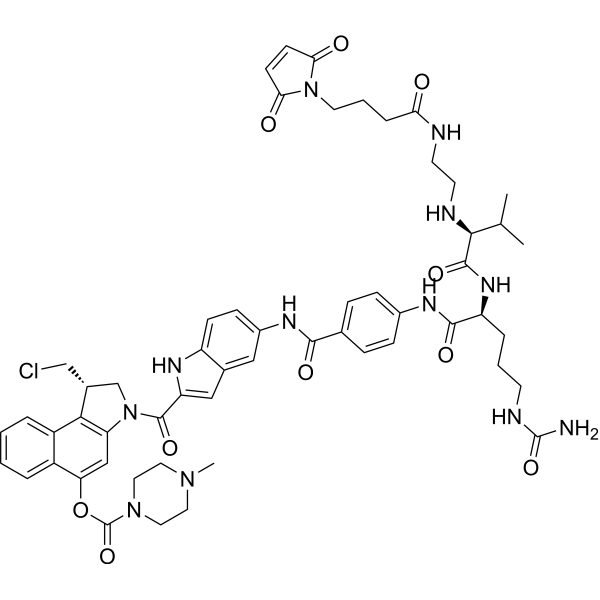
-
- HY-16293
-
|
PM01183; LY-01017
|
DNA Alkylator/Crosslinker
DNA/RNA Synthesis
|
Cancer
|
|
Lurbinectedin (PM01183) is a DNA minor groove covalent binder with potent anti-tumour activity; inhibits RMG1 and RMG2 cell growth with IC50 values of 1.25 and 1.16 nM, respectively.
|
-

-
- HY-130978
-
|
|
DNA Alkylator/Crosslinker
ADC Cytotoxin
|
Cancer
|
|
Duocarmycin DM, a DNA minor-groove alkylator, is an antibody agent conjugates (ADCs) toxin. Duocarmycin DM is based on its characteristic curved indole structure and a spirocyclopropylcyclohexadienone electrophile to act anticancer activity .
|
-
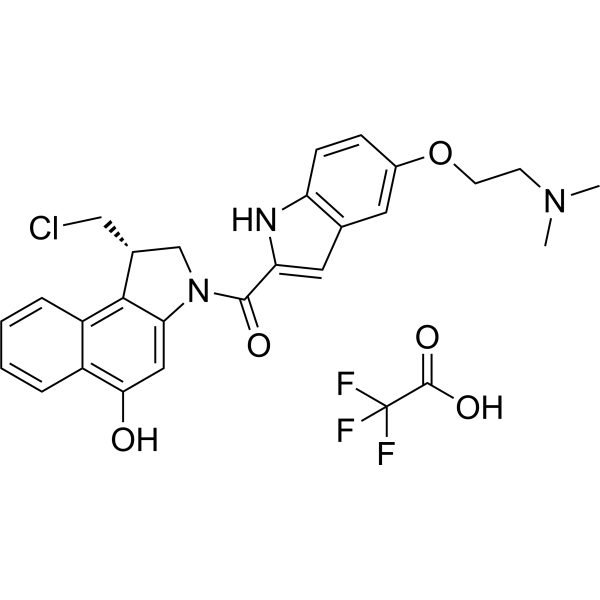
-
- HY-128904
-
|
|
Drug-Linker Conjugates for ADC
|
Cancer
|
|
MC-Val-Cit-PAB-duocarmycin chloride is a agent-linker conjugate for ADC with potent antitumor activity by using Duocarmycin (a DNA minor groove binding alkylating agent), linked via the ADC linker MC-Val-Cit-PAB.
|
-
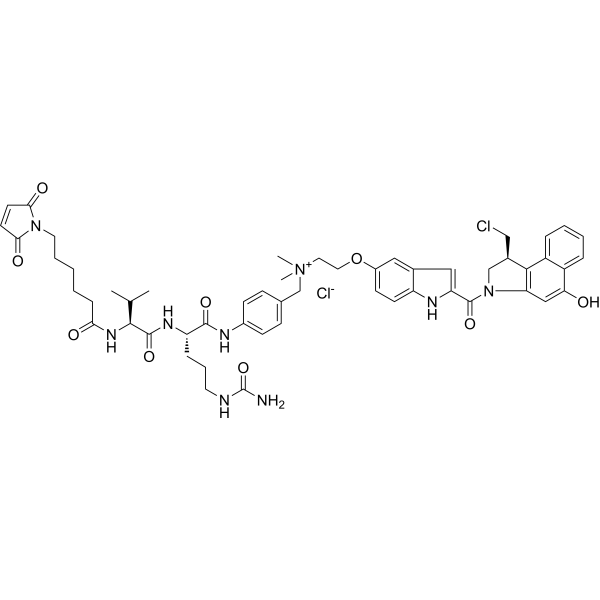
-
- HY-B1953
-
|
|
|
|
|
Thiacloprid, a chloronicotinyl insecticide, is targeted chiefly to control aphid pest species in orchards and vegetables . Thiacloprid destabilizes DNA. Thiacloprid changes the structure and stability of DNA through binding into the minor groove by hydrophobic or hydrogen interactions .
|
-

-
- HY-N6800A
-
-
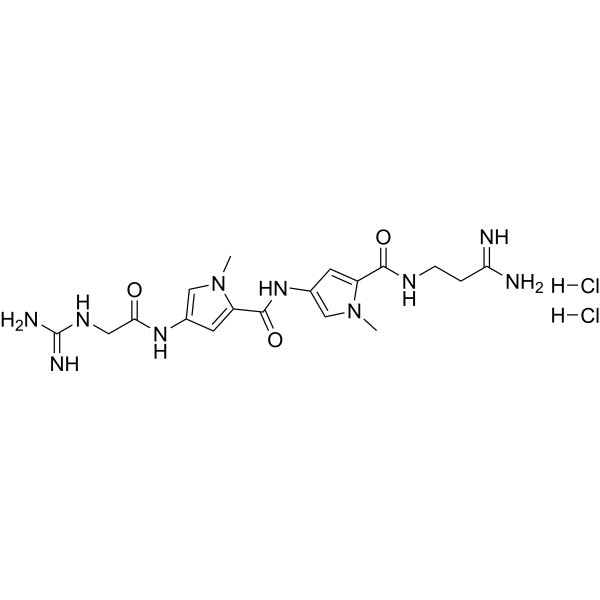
-
- HY-128915
-
|
|
DNA Alkylator/Crosslinker
ADC Cytotoxin
|
Cancer
|
|
Duocarmycin DM free base, a DNA minor-groove alkylator, is an antibody agent conjugates (ADCs) toxin. Duocarmycin DM free base is based on its characteristic curved indole structure and a spirocyclopropylcyclohexadienone electrophile to act anticancer activity .
|
-

-
- HY-101160
-
|
DRG16
|
DNA Alkylator/Crosslinker
ADC Cytotoxin
|
Cancer
|
|
SG2057 (DRG16) is a PBD dimer containing a pentyldioxy linkage which binds sequence selectively in the minor groove of DNA forming DNA interstrand and intrastrand cross-linked adducts. SG2057 is a highly active antitumor agent .
|
-
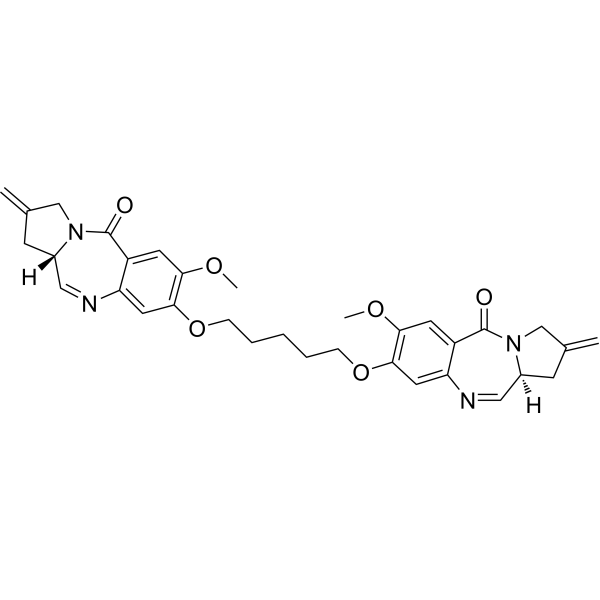
-
- HY-12457
-
|
CC-1065; NSC 298223
|
Antibiotic
DNA/RNA Synthesis
|
Infection
Cancer
|
|
Rachelmycin (CC-1065) is an antitumor antibiotic and a DNA-alkylating agent. Rachelmycin has cytotoxic potency that can be used as a cytotoxin to synthesis ADC. Rachelmycin effectively inhibits DNA synthesis. Rachelmycin can be used for cancer and infection research .
|
-
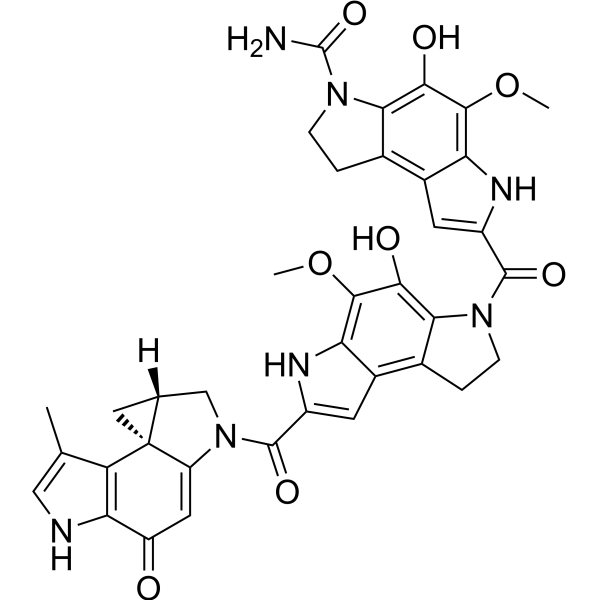
-
- HY-16293S
-
|
PM01183-d3; LY-01017-d3
|
DNA Alkylator/Crosslinker
DNA/RNA Synthesis
|
Cancer
|
|
Lurbinectedin-d3 is deuterium labeled Lurbinectedin. Lurbinectedin (PM01183) is a DNA minor groove covalent binder with potent anti-tumour activity; inhibits RMG1 and RMG2 cell growth with IC50 values of 1.25 and 1.16 nM, respectively[1].
|
-

-
- HY-B1953S
-
|
|
DNA Stain
Parasite
|
Infection
|
|
Thiacloprid-d4 is the deuterium labeled Thiacloprid[1]. Thiacloprid, a chloronicotinyl insecticide, is targeted chiefly to control aphid pest species in orchards and vegetables[1]. Thiacloprid destabilizes DNA. Thiacloprid changes the structure and stability of DNA through binding into the minor groove by hydrophobic or hydrogen interactions[2].
|
-
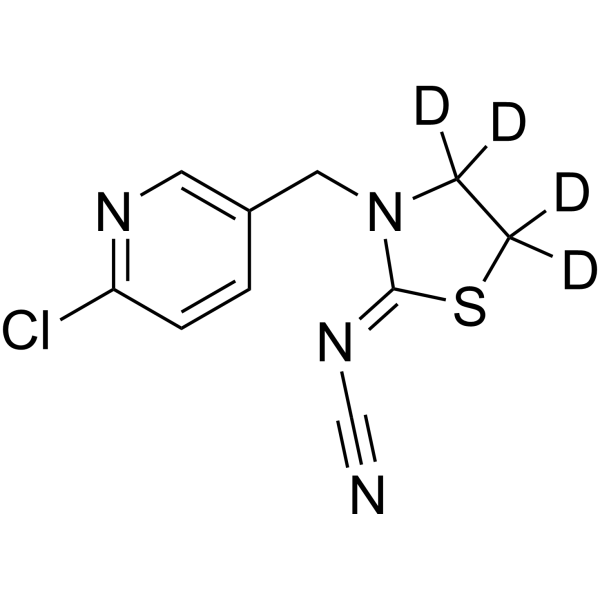
-
- HY-135900
-
|
|
ADC Cytotoxin
Bacterial
|
Cancer
|
|
Aniline-MPB-amino-C3-PBD is a cytotoxic agent comprised non-alkylating group. Aniline-MPB-amino-C3-PBD is a sequence-selective DNA minor-groove binding agent. Aniline-MPB-amino-C3-PBD acts as the payload for ADCs. Antimicrobial activity .
|
-
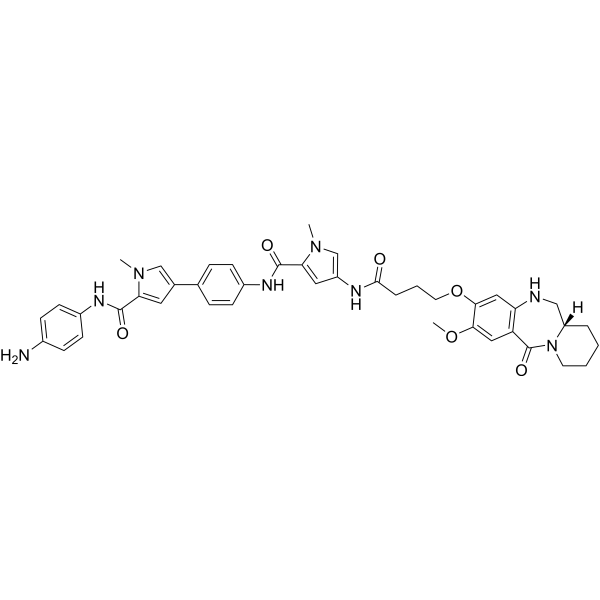
-
- HY-152187
-
|
|
Topoisomerase
Apoptosis
|
Others
|
|
Topoisomerase IIα-IN-5 is a topoisomerase II (topo II) α catalytic inhibitor. Topoisomerase IIα-IN-5 intercalates into DNA and binds to the DNA minor groove. Topoisomerase IIα-IN-5 exhibits better efficacy and less genotoxicity than Etoposide (HY-13629) .
|
-
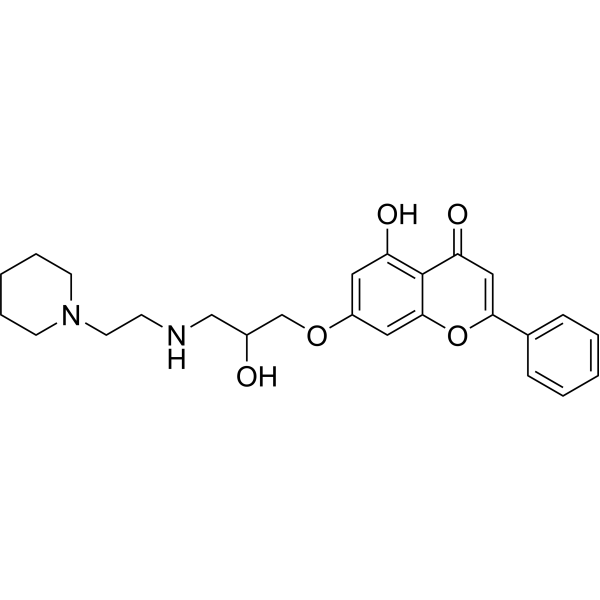
-
- HY-D1738
-
|
4',6-Diamidino-2-phenylindole dilactate
|
Fluorescent Dye
|
|
|
DAPI (dilactate) is a blue fluorescent dye that preferentially binds dsDNA and binds to minor groove AT clusters. DAPI (dilactate) is combined with dsDNA, and the fluorescence was enhanced about 20-fold. DAPI (dilactate) can be used to identify the cell cycle and specifically stains the nucleus but not the cytoplasm. DAPI (dilactate) form is more soluble in water than DAPI (dihydrochloride) form.
|
-
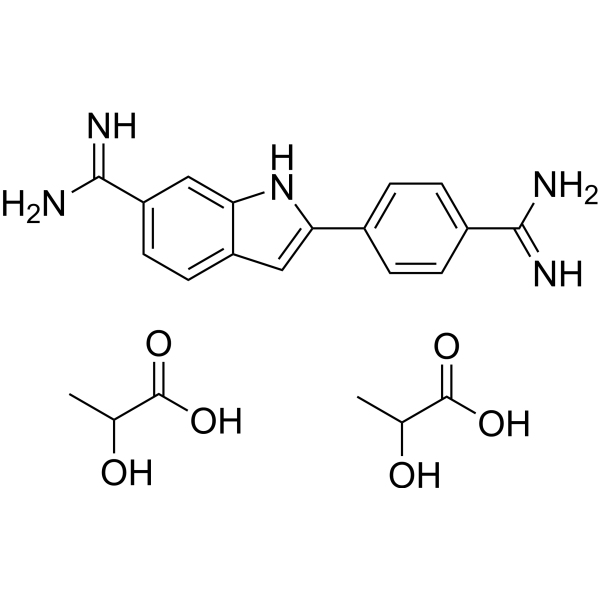
-
- HY-50936
-
|
Ecteinascidin 743; ET-743
|
Reactive Oxygen Species
Apoptosis
|
Inflammation/Immunology
Cancer
|
|
Trabectedin (Ecteinascidin 743; ET-743) is a tetrahydroisoquinoline alkaloid with potent antitumor activity. Trabectedin binds to the minor groove of DNA, blocks transcription of stress-induced proteins, induces DNA backbone cleavage and cancer cells apoptosis, and increases the generation of ROS in MCF-7 and MDA-MB-453 cells. Trabectedin has the potential for soft tissue sarcoma and ovarian cancer research .
|
-
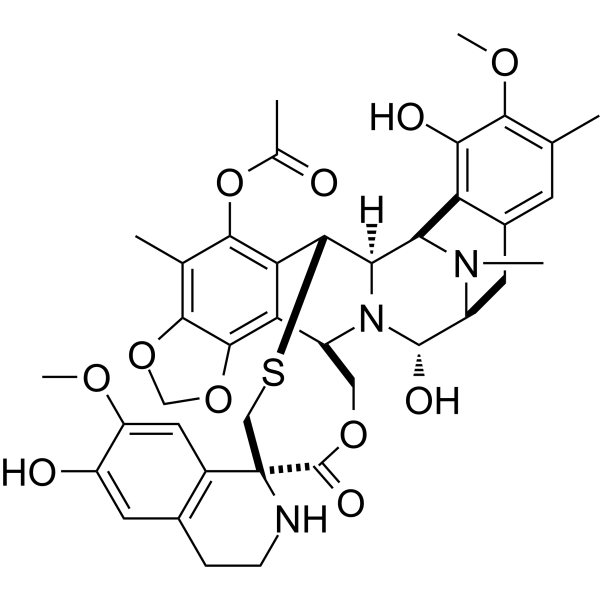
-
- HY-112898
-
|
|
ADC Cytotoxin
|
Cancer
|
|
DC1Sme, a DC1 derivative, exhibits IC50 values of 22 pM, 10 pM, 32 pM and 250 pM for Ramos, Namalwa, HL60/s and COLO 205 cancer cells, respectively. DC1, an analogue of the minor groove-binding DNA alkylator CC-1065, is a ADC Cytotoxin. DC1 can be used in synthesis of antibody-drug conjugates for the targeted treatment of cancer.
|
-

-
- HY-128952
-
|
SG3249
|
Drug-Linker Conjugates for ADC
DNA Alkylator/Crosslinker
|
Cancer
|
|
Tesirine (SG3249) is an antibody-drug conjugate (ADC) pyrrolobenzodiazepine (PBD) dimer payload. Tesirine combines potent antitumor activity with desirable physicochemical properties such as favorable hydrophobicity and improved conjugation characteristics. SG3199 (HY-101161) is the released warhead component of the ADC payload Tesirine. SG3199 retains picomolar activity in a panel of cancer cell lines. PBD dimers are highly efficient DNA minor groove cross-linking agents with potent cytotoxicity .
|
-
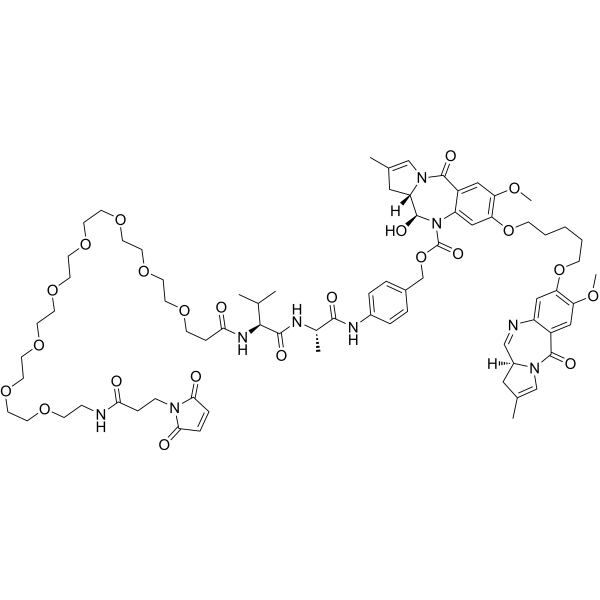
-
- HY-129379
-
|
|
ADC Cytotoxin
|
Cancer
|
|
DC0-NH2 is an effector moiety for ADC and a simplified analog of DC1 with better stability. DC0-NH2 is about 1000-fold more cytotoxic than commonly used anticancer agents (ex. Doxorubicin). DC0-NH2 can bind to the minor groove of DNA, followed by alkylation of adenine residues by its propabenzindole (CBI) component .
|
-
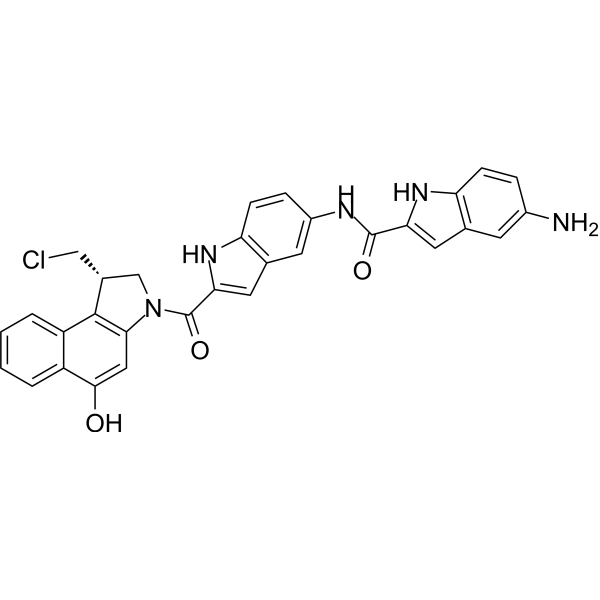
-
- HY-50936S
-
|
Ecteinascidin 743-d3; ET-743-d3
|
Isotope-Labeled Compounds
Reactive Oxygen Species
Apoptosis
|
Inflammation/Immunology
Cancer
|
|
Trabectedin D3 (Ecteinascidin 743 D3) is deuterium labeled Trabectedin. Trabectedin is a tetrahydroisoquinoline alkaloid with potent antitumor activity. Trabectedin binds to the minor groove of DNA, blocks transcription of stress-induced proteins, induces DNA backbone cleavage and cancer cells apoptosis, and increases the generation of ROS in MCF-7 and MDA-MB-453 cells. Trabectedin has tje potential for soft tissue sarcoma and ovarian cancer treatment .
|
-

-
- HY-D0814
-
|
4',6-Diamidino-2-phenylindole dihydrochloride
|
DNA Stain
|
Others
|
|
DAPI dihydrochloride is a DAPI dye. DAPI is a fluorescent dye that binds strongly to DNA. It binds to the AT base pair of the double-stranded DNA minor groove, and one DAPI molecule can occupy three base pair positions. The fluorescence intensity of DAPI molecules bound to double-stranded DNA is increased by about 20 times, and it is commonly observed with fluorescence microscopy, and the amount of DNA can be determined based on the intensity of fluorescence. In addition, because DAPI can pass through intact cell membranes, it can be used to stain both live and fixed cells .
|
-
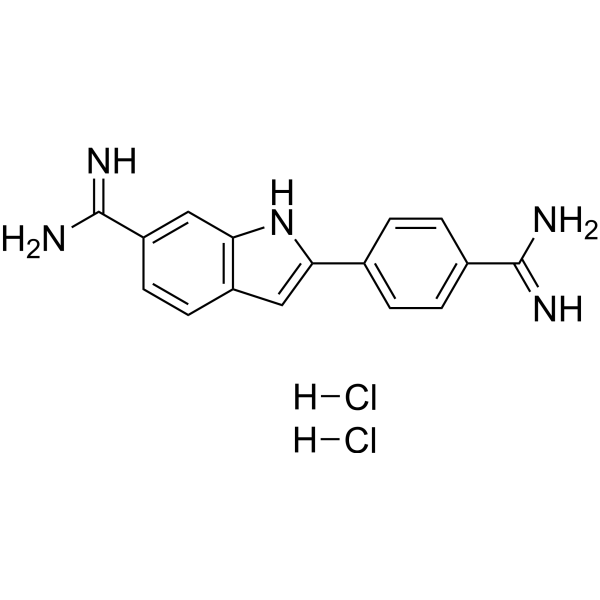
-
- HY-D1396
-
Br-DAPI
3 Publications Verification
|
Fluorescent Dye
DNA Stain
|
Others
|
|
Br-DAPI is a marker dye in DAPI series. DAPI is a fluorescent dye that binds strongly to DNA. It binds to the AT base pair of the double-stranded DNA minor groove, and one DAPI molecule can occupy three base pair positions. The fluorescence intensity of DAPI molecules bound to double-stranded DNA is increased by about 20 times, and it is commonly observed with fluorescence microscopy, and the amount of DNA can be determined based on the intensity of fluorescence. In addition, because DAPI can pass through intact cell membranes, it can be used to stain both live and fixed cells . Storage: Keep away from light.
|
-
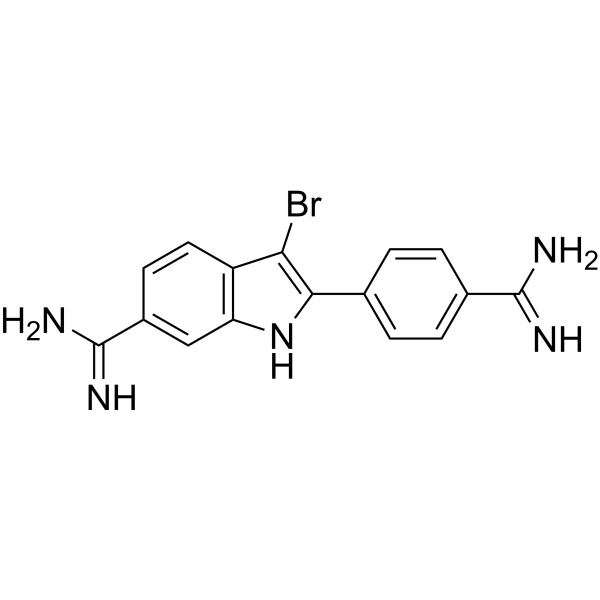
| Cat. No. |
Product Name |
Type |
-
- HY-D0814
-
|
4',6-Diamidino-2-phenylindole dihydrochloride
|
Fluorescent Dyes/Probes
|
|
DAPI dihydrochloride is a DAPI dye. DAPI is a fluorescent dye that binds strongly to DNA. It binds to the AT base pair of the double-stranded DNA minor groove, and one DAPI molecule can occupy three base pair positions. The fluorescence intensity of DAPI molecules bound to double-stranded DNA is increased by about 20 times, and it is commonly observed with fluorescence microscopy, and the amount of DNA can be determined based on the intensity of fluorescence. In addition, because DAPI can pass through intact cell membranes, it can be used to stain both live and fixed cells .
|
-
- HY-D1738
-
|
4',6-Diamidino-2-phenylindole dilactate
|
Fluorescent Dyes/Probes
|
|
DAPI (dilactate) is a blue fluorescent dye that preferentially binds dsDNA and binds to minor groove AT clusters. DAPI (dilactate) is combined with dsDNA, and the fluorescence was enhanced about 20-fold. DAPI (dilactate) can be used to identify the cell cycle and specifically stains the nucleus but not the cytoplasm. DAPI (dilactate) form is more soluble in water than DAPI (dihydrochloride) form.
|
| Cat. No. |
Product Name |
Category |
Target |
Chemical Structure |
| Cat. No. |
Product Name |
Chemical Structure |
-
- HY-16293S
-
|
|
|
Lurbinectedin-d3 is deuterium labeled Lurbinectedin. Lurbinectedin (PM01183) is a DNA minor groove covalent binder with potent anti-tumour activity; inhibits RMG1 and RMG2 cell growth with IC50 values of 1.25 and 1.16 nM, respectively[1].
|
-

-
- HY-50936S
-
|
|
|
Trabectedin D3 (Ecteinascidin 743 D3) is deuterium labeled Trabectedin. Trabectedin is a tetrahydroisoquinoline alkaloid with potent antitumor activity. Trabectedin binds to the minor groove of DNA, blocks transcription of stress-induced proteins, induces DNA backbone cleavage and cancer cells apoptosis, and increases the generation of ROS in MCF-7 and MDA-MB-453 cells. Trabectedin has tje potential for soft tissue sarcoma and ovarian cancer treatment .
|
-

-
- HY-B1953S
-
|
|
|
Thiacloprid-d4 is the deuterium labeled Thiacloprid[1]. Thiacloprid, a chloronicotinyl insecticide, is targeted chiefly to control aphid pest species in orchards and vegetables[1]. Thiacloprid destabilizes DNA. Thiacloprid changes the structure and stability of DNA through binding into the minor groove by hydrophobic or hydrogen interactions[2].
|
-

Your information is safe with us. * Required Fields.
Inquiry Information
- Product Name:
- Cat. No.:
- Quantity:
- MCE Japan Authorized Agent:











































